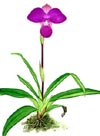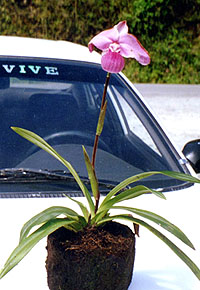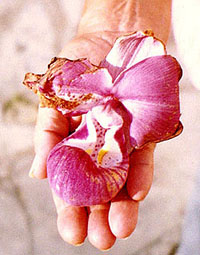|
SELBY GARDENS IDENTIFIES SPECTACULAR NEW ORCHID SPECIES
FROM PERU
Research scientists in the
Marie Selby Botanical Gardens Orchid Identification Center
are jubilant about a spectacular new species of Peruvian orchid
- Phragmipedium kovachii - which last week they were the first
to describe for the botanical world.
Phragmipedium kovachii is twice as big as other members
of the
Phragmipedium genus, covering the palm of an average personfs
hand. It boasts vivid flowers that range in color from pinkish
to dark purple. (The typical Phragmipedium is a much drabber
green or brown.)
The species was discovered by and named for Michael Kovach,
a horticulturist from western Virginia who has been involved
in sustainable agriculture efforts with villagers in northeastern
Peru. Kovach brought a dried, pressed specimen of the plant to
the Orchid Identification Center on June 5, where it was described
by John T. Atwood and Stig Dalstrom of Selby Gardens, with assistance
from Ricardo Fernandez of the Museo de Historia Natural in Lima.
The findings were published last Wednesday, June 12, in the Gardensf
scientific journal, Selbyana.
gOut of the thousands of orchids to have been discovered
in the past 100 years, this is either the most spectacular or
one of the six most spectacular, depending on who you talk to,h
says John Beckner, curator of the Gardens Orchid Identification
Center, who was involved in developing the scientific description.
Beckner and Dr. Wesley Higgins, Director of the Orchid
Identification Center, say that only the OICfs description of
Phragmipedium besseae in 1981 was as great a triumph for Selby
Gardens. But, while its vivid orangy-red color was a sensational
find, the Phragmipedium besseae was much smaller than this new
species. gThis has got to be one of the most important plant
discoveries for Selby Gardens and for the entire orchid world,
in the past 100 years,h says Beckner. gIt is going to open up
a whole new line of orchid hybridizing.h
In the botanical world, the institution and author that
describe a new species will have their names forever linked with
that species. The discovery of a new species starts a scientific
race to publication where the winner earns the right to name
the species. The authorfs name gets carried along and the publication
(in this case, Selbyana) goes along with the plant forever. The
pressed and dried plant specimen itself was returned to the country
of origin: the Museo de Historia Natural in Lima, Peru.
Selby Gardens has the largest concentration of American
Orchid Society certified taxonomists of any institution in the
world. The Gardensf OIC describes perhaps a dozen or more new
species each year, and identifies hundreds more. Beckner says
that gbig showy orchids like the Phragmipedium kovachii are few
and far between.h
Beckner says that when he gave a report about the new species
to a meeting of the Florida West Coast Orchid Society in Clearwater
last week, git was boom - people got very excited. They kept
saying, eWow!f eWow!.f
|
020620


